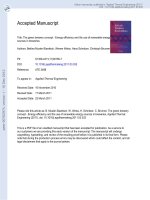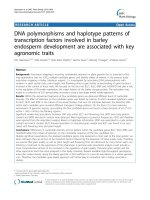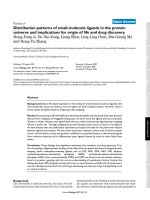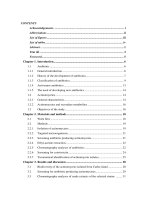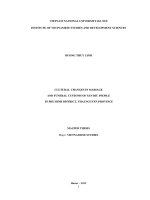Biodiversity and distribution patterns of free-living nematode communities in Ba Lai river, Ben Tre province
Bạn đang xem bản rút gọn của tài liệu. Xem và tải ngay bản đầy đủ của tài liệu tại đây (1.31 MB, 12 trang )
Vietnam Journal of Science and Technology 56 (2) (2018) 224-235
DOI: 10.15625/2525-2518/56/2/10667
BIODIVERSITY AND DISTRIBUTION PATTERNS OF
FREE-LIVING NEMATODE COMMUNITIES IN BA LAI RIVER,
BEN TRE PROVINCE
Tran Thanh Thai1, *, Nguyen Le Que Lam1, Nguyen Thi My Yen2,
Ann Vanreusel2, Ngo Xuan Quang1
1
Institute of Tropical Biology, Vietnam Academy of Science and Technology,
85 Tran Quoc Toan Street, District 3, Ho Chi Minh City, Viet Nam
2
Ghent University, Krijgslaan 281, S8, B-9000 Ghent, Belgium
*
Email:
Received: 13 September 2017; Accepted for publication: 11 January 2018
Abstract. Nematode communities in Ba Lai river, Ben Tre province were investigated in
September of 2015 (eight stations from estuary to upstream). The results showed that the
nematode communities have characterized by high density and biodiversity, providing useful
information of nematode assemblages in freshwater habitas, in particular inland river. Also the
results indicated that the distribution of nematode communities in Ba Lai river was strongly
discriminated between in and outside of dam with two groups. The Ba Lai dam may be reasons
for cause the nematodes distribution discontinuity. Present study is a pioneering attempt to
record the impact of the dam on benthic - invertebrate in Viet Nam.
Keywords: Ba Lai dam, Ben Tre province, biodiversity, dam effect, distribution, nematode
communities.
Classification numbers: 3.1.2; 3.4.2
1. INTRODUCTION
Currently, Mekong river is internationally recognised as the second most biodiversity river
in the world (after the Amazon river) [1, 2]. There are current estimated at least 1,200 species of
fish, possibly reaching 1,700 and high diversity is also exhibited by other aquatic animal and
plant communities [3]. While studies and reviews on fish species diversity in Mekong river are
increasingly common, to date, accuracy of other aquatic animal and plant groups diversity in the
Mekong river estimation have not yet been revealed, despite the fact that 30% of the production
from the fishery comes from non - fish sources [3]. Other aquatic animal have not been used
directly as food and goods produced from natural resources but its (especially benthic fauna
communities) have the potential to used as good biological monitoring for the ecological quality
status of sediment [4, 5, 6]. Of all the benthic fauna groups, macrofauna (> 0.5 mm in size
fraction) have been the organisms most frequently used as a longer - term biological monitoring
Biodiversity and distribution patterns of free-living nematode communities in Ba Lai river
program in the Mekong river [7]. In recent years, meiofauna (ranged from 38 µm to less than 0.5
mm in size fraction) are have been used successfully for detecting sediment condition [8, 9, 10,
11]. The study by Ngo et al. (2016) is notable in that nematodes (domination numerically in the
meiofauna communities) can be considered as a good candidate organisms for environmental
monitoring [12]. However, in Vietnam, most of research on nematode communities were
conducted in the coastal area: Ha Long Bay [13, 14], Nha Trang Bay [15], Mekong estuaries
[12, 16], Can Gio and Ca Mau mangrove forest [17, 18]. Few studies have been carried out for
nematode communities in freshwater habitats, such as Sai Gon river [19], Cau, Day, Cam and
Nhue river [20]. Overall, basic information regarding the composition and biodiversity of
nematode communities is still largely lacking for freshwater area, in particular inland river.
Ba Lai river is one of four branches of the Tien river which is the main northern distributary
of the Mekong through Vietnam. In 2002, a irrigation dam (called Ba Lai dam) was built across
the river to stop the infiltration of salt water and conserve fresh water for 88,500 hectares of
farmland in Ben Tre province. Since then, several studies have warned that a lightly disturbed in
Ba Lai’s environmental sediment quality and river - estuarine has already been deposited. Ba Lai
dam could be one of the major reasons for the disturbance and deposition of this river [21].
As mentioned above, the purpose of this research was to: (i) to survey of nematode
assemblages in the Ba Lai river (from estuary to upstream) by assessing their composition,
density and diversity and also (ii) determine effects of Ba Lai dam on the distribution of
nematode communities.
2. MATERIALS AND METHODS
2.1. Sampling area and field operations
Figure 1. Sampling stations in Ba Lai river, Ben Tre province.
225
Tran Thanh Thai, Nguyen Le Que Lam, Nguyen Thi My Yen, Ann Vanreusel, Ngo Xuan Quang
Table 1. Station characteristics.
Stations
Latitude
Longitude
BL1
10°1'52.61"N
106°41'23.65"E
BL2
10°5'19.96"N
106°41'6.25"E
BL3
10°8'28.69"N
106°37'58.45"E
BL4
10°8'48.09"N
106°37'37.86"E
BL5
10°11'37.71"N
106°34'10.46"E
BL6
10°13'28.04"N
106°30'24.00"E
BL7
10°15'47.23"N
106°26'36.73"E
BL8
10°17'16.27"N
106°23'20.41"E
In September of 2015, nematode samples were collected at eight low intertidal sampling
stations (BL1, BL2, BL3, BL4, BL5, BL6, BL7 and BL8), located along the Ba Lai river, Ben
Tre province (Fig. 1). Station characteristics are given in Table 1. Three replicates were taken at
each station and samples were collected using cores of 3.5 cm in diameter (10 cm2 surface area)
and 30 cm in length. The cores were pushed down into the soft - bottom up to 10 cm deep. The
samples were all fixed in a 7 % formaldehyde solution at 60 °C and gently stirred before
transportation to the laboratory of Department of Environmental Management and Technology,
Institute of Tropical Biology.
2.2. Laboratory techniques
In the laboratory, nematode samples were sieved through a 38 µm mesh and extracted by
flotation technique with Ludox - TM50 solution (specific gravity of 1.18) [22]. Samples were
discolored with 3 – 5 mL Rose Bengal solution (1 %). All individual numbers were counted
under a stereomicroscope, two hundred nematodes were used for making slides with glycerine +
ethanol solution [23] before identification. Nematodes were identified to genus level by using
the following taxonomy literature: Platt & Warwick (1983, 1988) [24, 25], Warwick et al.
(1988) [26], Zullini (2005) [27], Nguyen (2007) [28] as well as the NeMys online identification
key [29].
2.3. Data analyses
Data of nematode communities was processed in Microsoft Excel 2007 to analyze the
composition, species richness (S) and densities. The software Primer v.6.1.6 was used to
measure the diversity indices such as Margalef diversity (d) [30], Shannon - Wiener diversity
226
Biodiversity and distribution patterns of free-living nematode communities in Ba Lai river
(H'(log2)) [31] and Hill indices (N1, N2 and Ninf) [32]. All the data per site were presented as
average ± standard deviation.
The distribution of the nematode communities were further explored by using MDS
analysis (non - metric multi - dimensional scaling) [33]. The data were transformed based
Square root. The MDS was used to produce 2D graphs base on the Bray – Curtis similarity index
in order to visualize similarity patterns. The SIMPROF method (SIMilarity PROfile) was used to
test for significant different station groups.
The significant differences in the univariate measures between sampling stations were
tested by the parametric test one - way ANOVA or the non - parametric Kruskal - Wallis test,
using the software STATISTICA 7.0. In order to test the assumption of homogeneity of
variances, the Levene’s test was used. Tukey HSD multiple comparison tests were used when
significant differences were detected (p < 0.05). Data were log - transformed prior to analysis
when assumptions were not fulfilled.
3. RESULTS AND DISCUSSION
3.1. The composition of nematode communities in Ba Lai river
The nematode assemblages in Ba Lai river, Ben Tre province consisted of 118 genera
belonging to 45 families, 12 orders such as Araeolaimida, Chromadorida, Desmodorida,
Desmoscolecida, Dorylaimida, Enoplida, Monhysterida, Mononchida, Plectida, Rhabditida,
Triplonchida and Tylenchida. During field sampling period, most individuals belong to three
dominant orders: Monhysterida (39.50% of total abundance), Araeolaimida (22.65 %) and
Enoplida (15.77 %). The subdominant orders were Chromadorida, Plectida, Desmodorida,
Mononchida and Dorylaimida (6.71, 4.84, 3.57, 2.92 and 2.79 %, respectively). The percentage
of the remaining orders ranged from 0.05 % to 0.65 % (Fig. 2).
Figure 2. Nematode orders composition.
227
Tran Thanh Thai, Nguyen Le Que Lam, Nguyen Thi My Yen, Ann Vanreusel, Ngo Xuan Quang
3.2. Nematodes density and diversity
Overall, the average density (inds/10cm2) of three stations outside the dam (BL1, 2 and 3)
were considerably higher than the remaining stations (BL4, 5, 6, 7 and 8) appeared inside the
dam. More specifically, BL1 was expressed as the highest density (4,580.33 ± 1,532.95)
followed by BL2 (3,435.33 ± 469.98) and BL3 (1,465.67 ± 393.76). By contrast, all stations
inside the dam were showed low density with a mean annual density ranged from 83.00 ± 16.98
(BL5) to 355.67 ± 43.41 (BL4) (Fig. 3A).
Figure 3. Characteristics of nematode communities. (A) Densities, (B) Species richness (S),
(C) Margalef diversity (d), Shannon - Wiener diversity (H'(log2)), (D) Hill indices (N1, N2 and Ninf).
As the same to results of densities, the average diversity indices such as genera
richness (S), Margalef diversity (d), Shanon - Wiener (H') and Hill indices (N1, N2 and Ninf) of
stations outside the dam were often higher than the stations where appeared inside the dam.
More specifically, the species richness (S) ranged from 13.00 ± 1.41 to 32.33 ± 2.52. BL1, 3, 2
were the station that presented the highest species richness (32.33 ± 2.52; 31.33 ± 2.52; 27.67 ±
3.21, respectively), whereas lowest values was found in BL5 (13.00 ± 1.41) (Fig. 3B). The
Margalef index measured from 2.86 ± 0.61 to 5.86 ± 0.49 and the Shanon - Wiener index
ranged from 2.79 ± 0.37 to 4.03 ± 0.49. The Hill indices, indicated average values ranging
228
Biodiversity and distribution patterns of free-living nematode communities in Ba Lai river
between 6.99 ± 1.25 - 16.43 ± 1.49 for N1, between 4.18 ± 0.78 - 11.64 ± 1.57 for N2, and
between 2.50 ± 0.46 - 6.45 ± 1.16 for Ninf. In general, station BL1 was always expressed as the
highest diversity values, whereas station BL5 (d, H', N1), BL8 (N2, Ninf) showed lowest diversity
index through field sampling period (Fig. 3C,D).
The results of an ANOVA/ Kruskal – Wallis showed significant differences between stations
for densities and all indices. A Post Hoc comparison showed significant differences between
sampling stations were found, such as BL1 with other stations (except for BL2), BL2 with the
remaining stations within densities (Table 2).
Table 2. The results of an ANOVA / Kruskal – Wallis and Post hoc comparison / Multiple comparison
for characteristics of nematode communities.
ANOVA
Variables
p value
Post hoc test
Densities
< 0.001
BL1 ≠ BL3, 4, 5, 6, 7, 8; BL2 ≠ BL3, 4, 5, 6, 7, 8
S
< 0.001
BL1 ≠ BL4, 5; BL5 ≠ BL2, 3, 6, 7
d
0.003
BL5 ≠ BL1, 3, 6
N1
< 0.001
BL1 ≠ BL4, 5, 6, 8; BL3 ≠ BL5, 8
N2
< 0.001
BL1 ≠ BL4, 5, 6, 8; BL3 ≠ BL8
Ninf
< 0.001
BL1 ≠ BL2, 3, 4, 5, 6, 7, 8
Kruskal – Wallis
Variables
p value
Multiple comparison of mean rank for all stations
H'
0.014
BL1 ≠ BL8
Although the studies on nematode communities have been widely conducted in Vietnam,
the knowledge on nematodes in freshwater habitats remains limited. Further more, the study by
Ngo et al. (2016) have demonstrated that nematode assemblages seems to give a good indication
of the environmental monitoring [12]. Therefore, the results of this study provides a base line for
further research on using nematodes for determining the ecological quality status of sediment in
Ba Lai river gradually disturbed.
Comparing our results with other studies has been difficult, mainly because of uncertainties
in exploring nematode communities in freshwater habitats. Therefore, it can be compared with
other comparable studies in the river estuary around the world. In general, the nematode
communities in Ba Lai river, Ben Tre province have been recorded in high density and diversity.
More specifically, the results showed nematode densities ranging from 83.00 ± 16.98 to 355.67
± 43.41 (stations inside the dam) and from 1,465.67 ± 393.76 to 4,580.33 ± 1,532.95
(inds/10cm2) (stations outside the dam). The density of stations where appeared outside the dam
were higher than observed in several studies such as by Wu et al. (2010) in Beigan River Basin
(ranged from 75 to 2,474 inds/10 cm2) [34] , by Ngo et al. (2010) in Mekong estuarine system
(683.7 ± 374.4 to 2,099 ± 100 in Ba Lai estuary and from 454 ± 289.9 to 3,137.7 ± 337.1
inds/10cm2 in other estuaries) [16], by Alves et al. (2009) in the Mira estuary (12.44 ± 3.91 2,234 ± 400 inds/10cm2) and in the Mondego estuary (38.93 ± 5.29 – 1,323.10 ± 389.52
inds/10cm2) [35]. More recently, the density of stations intside the dam were within the ranges
229
Tran Thanh Thai, Nguyen Le Que Lam, Nguyen Thi My Yen, Ann Vanreusel, Ngo Xuan Quang
found by Ngo et al. (2017) in Sai Gon river (ranged between 13.3 ± 2.9 to 408.7 ± 142.5 in the
dry season) but our estimates were lower than the nematode densities in the wet season (from 58
± 41.9 to 1,649.7 ± 1,462 inds/10cm2) [19]. Meiofaunal density are often increasing with
increasing salinity [36]. It could be one of the major reasons why the density of stations outside
the dam were considerably higher than the remaining stations appeared inside the dam.
The nematode communities in Ba Lai river are not only characterized by high density, but
by a high diversity with 118 genera belonging to 45 families, 12 orders. The nematode diversity
expressed as a number of genera were lower than in the eight estuaries of the Mekong river, with
135 genera [16] or the 120 genera in five European estuaries [36]. Howere, the nematode
diversity expressed as a number of families, our estimates were higher than Mekong estuarine
and European estuaries system (with 35 families for each locations). Addition, the number of
genera and families of nematode assemblages in the Ba Lai river were higher than the genera
reported in the Mondego and Mira estuaries, with 45 genera belonging to 19 families [37], but
also in Sai Gon river (88 genera, 42 families, 10 orders in dry and 102 genera, 45 families, 10
orders in wet season) as published by Ngo et al. (2017) [19].
Regarding nematode diversity indices, the Shannon diversity of nematode communities in
Ba Lai river (2.79 ± 0.37 to 4.03 ± 0.49) were considerably higher than observed in Sai Gon
river, with ranged from 0.62 ± 0.67 to 3.43 ± 0.17 [19]. However, the Margalef and Shanon wiener index in this study were very similar to the more recently observed by Ngo et al. (2010)
in Mekong estuarine system, with the Margalef index ranged from 2.64 ± 0.64 to 5.99 ± 1.06
and the Shanon - Wiener index varied between 1.83 ± 0.59 to 4 ± 0.17 [16].
3.3. Exploring the distribution of nematode communities in Ba Lai river by using
SIMPROF and MDS
The SIMPROF based on relative nematode abundances provided two statistically
significant groups at the level of 30%, in which one is further subdivided at the level of 40% in
three subgroups. Also one outlying stations were identified, not classified in one of the three
subgroups (Fig. 4A). The first group includes all stations appeared inside the dam (except for
BL4.2). The second main group consisted of three subgroups. The subgroup A including the
stations BL1.1, 1.2, 1.3 and the subgroup B including the stations BL2.1, 2.2, 2.3; while the
subgroup C including the stations BL3.1, 3.2, 3.3. All stations of second group were distributed
outside the dam. Figure 4B shows the MDS results with the four groups encircled as they were
identified by SIMPROF.
3.4. The Ba Lai dam may be reasons for cause the nematode distribution discontinuity
In recent years, many studies have demonstrated that the negative impacts of dams on the
environment such as the hydrological system, river dynamics diversion and also alteration in bio
- geochemical cycling [38, 39]. Addition, dam construction and operation can make a substantial
contribution to ecosystem hazards, things like loss of forests and wildlife habitats, loss of aquatic
diversity, including upstream and downstream fisheries, interruption of fish migration and loss
of the services of downstream wetlands, riverine and estuarine ecosystems [40, 41].
Ecologically, dams have the ability to change river’s physicochemical characteristics that are the
major reasons for change in the aquatic communities structure [42]. Clearly, nematode
communities distribution was strongly discriminated between in and outside of dam.
Unfortunate, there are lack of information about environmental conditions in - and outside of the
dam in this study.
230
Biodiversity and distribution patterns of free-living nematode communities in Ba Lai river
A
B
Figure 4. Patterns of nematode communities distribution. (A) The SIMPROF analysis of nematode
assemblages in Ba Lai river, (B) The MDS based on Square root transformed densities with overlying
clusters at two similarity levels.
231
Tran Thanh Thai, Nguyen Le Que Lam, Nguyen Thi My Yen, Ann Vanreusel, Ngo Xuan Quang
Together, these findings show that the Ba Lai dam may lead to nematode distribution
discontinuity. Similar results have been reported by Mueller et al. (2011), patterns of
macroinvertebrate communities structure strongly discriminated between in and outside of dam,
which probably results from different flow conditions in - and outside of dam [42]. More precise
estimates of the impacts of Ba Lai dam will become possible when we have a stduy compared
the abiotic characteristics in and outside of dam as well as their effects on the other aquatic
groups such as periphyton, aquatic macrophytes, macroinvertebrate and fish.
4. CONCLUSION
The nematode communities in Ba Lai river, Ben Tre provinve are not only characterized by
high density, but by a high diversity. Supporting the base line for further research on using
nematodes for determining the ecological quality status of sediment in Ba Lai river gradually
disturbed. Also the nematode communities distribution was strongly discriminated between in
and outside of dam with two groups. More specifically, the first group includes all stations
appeared inside the dam and the second main group (distributed outside the dam) consisted of
three subgroups. The Ba Lai dam may be reasons for cause the nematode distribution
discontinuity. Present study is a pioneering attempt to record the impact of the dam on benthic invertebrate in Vietnam.
Acknowledgements:
ZEIN2015PR414.
The
research
is
funded
by
project
VAST.HTQT.NGA.01/17-18
and
REFERENCES
1.
Kottelat M., and Whitten T. - Freshwater biodiversity in Asia: with special reference to
fish (Vol. 343), World Bank Publications, Washington, DC. USA, 1996.
2.
Ziv G., Baran E., Nam S., Rodríguez - Iturbe I., and Levin S. A. – Trading - off fish
biodiversity, food security, and hydropower in the Mekong River Basin, Proceedings of
the National Academy of Sciences, USA 109 (2012) 5609 - 5614.
3.
Coates D., Ouch P., Ubolratana S., Nguyen T. T., and Sinthavong V. - Biodiversity and
fisheries in the Lower Mekong Basin, Mekong Development Series No. 2, Mekong River
Commission, Phnom Penh, Cambodia, 2003.
4.
Borja A., Muxika I., and Franco J. - The application of a Marine Biotic Index to different
impact sources affecting soft - bottom benthic communities along European
coasts, Marine Pollution Bulletin 46 (7) (2003) 835 - 845.
5.
Dauvin J. C., Ruellet T., Desroy N., and Janson A. L. - The ecological quality status of the
Bay of Seine and the Seine estuary: use of biotic indices, Marine Pollution Bulletin 55 (1)
(2007) 241 - 257.
6.
Teixeira H., Weisberg S. B., Borja A., Ranasinghe J. A., Cadien D. B., Velarde R. G., ...
and Ritter K. J. - Calibration and validation of the AZTI's Marine Biotic Index (AMBI)
for Southern California marine bays, Ecological Indicators 12 (1) (2012) 84 - 95.
7.
Mekong River Commission. - Biomonitoring Methods for the Lower Mekong Basin,
Mekong River Commission, Vientiane, 2010.
232
Biodiversity and distribution patterns of free-living nematode communities in Ba Lai river
8.
Moreno M., Vezzulli L., Marin V., Laconi P., Albertelli G., and Fabiano M. - The use of
meiofauna diversity as an indicator of pollution in harbours, ICES Journal of Marine
Science 65 (8) (2008) 1428 - 1435.
9.
Alves A. S., Adão H., Ferrero T. J., Marques J. C., Costa M. J., and Patrício J. - Benthic
meiofauna as indicator of ecological changes in estuarine ecosystems: the use of
nematodes in ecological quality assessment, Ecological Indicators 24 (2013) 462 - 475.
10. Semprucci F., Balsamo M., and Sandulli R. - Assessment of the ecological quality (EcoQ)
of the Venice lagoon using the structure and biodiversity of the meiofaunal
assemblages, Ecological Indicators 67 (2016) 451 - 457.
11. Semprucci F., Balsamo M., Appolloni L., and Sandulli R. - Assessment of ecological
quality status along the Apulian coasts (eastern Mediterranean Sea) based on meiobenthic
and nematode assemblages, Marine Biodiversity 1 (2017) 1 - 11.
12. Ngo X. Q ., Chau N. N., Smol N., Prozorova L., and Vanreusel A. - Intertidal nematode
communities in the Mekong estuaries of Vietnam and their potential for
biomonitoring, Environmental monitoring and assessment 188 (2) (2016) 91.
13. Nguyen V.T., and Nguyen D.T. - Biodiversity of the marine nematodes in the coastline of
Ha Long Bay and their use for the assessment and biomonitoring of water environment,
Journal of Marine Science and Technology 32 (2003) 51- 63.
14. Olga P., Yulia T., Nguyen V.T., Nguyen D.T. - Meiobenthos in Estuary Part of Ha Long
Bay Gulf of Tonkin, South China Sea, Vietnam, Ocean Science Journal 43 (3) (2008) 153
- 160.
15. Olga P., Yulia T.. - Meiobenthos in Nha Trang Bay of the South China Sea Vietnam,
Ocean Science Journal 41 (3) (2006) 139 - 148.
16. Ngo X. Q., Vanreusel A., Smol N., and Chau N. N. - Meiobenthos assemblages in the
mekong estuarine system with special focus on free-living marine nematodes, Ocean
Science Journal 45 (4) (2010) 213 - 224.
17. Ngo X. Q., Vanreusel A., Thanh N. V., and Smol N. - Biodiversity of meiofauna in the
intertidal Khe Nhan mudflat, Can Gio mangrove forest, Vietnam with special emphasis on
free living nematodes, Ocean Science Journal 42 (3) (2007) 135.
18. Tran T. T., My Yen N. T., Tho N., and Quang N. X. - Meifaunua in the mangrove-shrimp
farms ponds, Ca Mau Province, Journal of Science and Technology, 55 (3) (2017) 271.
19. Ngo X. Q., Yen N. T. M., Van Dong N., Prozorova L., Smol N., Lins L., and Vanreusel A
.- Nematode communities in the Sai Gon River harbors in relation to tributyltin
concentrations, Marine Biodiversity 1 (2017) 1 - 13.
20. Nguyen T. T., and Thanh N. V. - Comparison on free-living nematode compositions of
the Cau, Day, Cam and Nhue rivers, Journal of Biology 27 (4) (2014) 36 - 42.
21. Nguyen T. S., and Nguyen M. H. - Study on deposition of Ba Lai estuary, Ben Tre
province, Journal of Science 27 (1) (2011) 211 - 217.
22. Vincx M. - Meiofauna in marine and freshwater sediments. In G. S. Hall (Ed.), Methods
for the examination of organismal diversity in soils and sediments, Wallinfort UK, 1996.
23. De Grisse A. T. - Redescription ou modifications de quelques technique utilis [a] es dan
l'etude des n [a] ematodes phytoparasitaires, 1969.
233
Tran Thanh Thai, Nguyen Le Que Lam, Nguyen Thi My Yen, Ann Vanreusel, Ngo Xuan Quang
24. Platt H. M., and Warwick R. M. - Free-living Marine Nematodes (Part I. British
Enoplids), Synopses of the British Fauna No 28, Linnean Society of London/Estuarine &
Brackish Water Society, 1983.
25. Platt H. M., and Warwick R. M. - Free-living Marine Nematodes (Part II. British
Chromadorids), Linnean Society of London and the Estuarine and Brackish - Water
Sciences Association, 1988.
26. Warwick R. M., Platt H. M., Somerfield P. J. - Free living marine nematodes (Part III.
Monhysterids), The Linnean Society of London and the Estuarine and Coastal Sciences
Association, London, 1988.
27. Zullini A. - The Identification manual for freshwater nematode genera, Lecture book,
MSc Nematology Ghent University, 2005.
28. Nguyen V. T. - Fauna of Vietnam. Free-living nematodes orders Monhysterida,
Araeolaimida, Chromadorida, Rhabditida, Enoplida, Mononchida and Dorylaimida,
Science Technology Publication, Hanoi, 2007.
29. Vanaverbeke J., Bezerra T. N., Braeckman U., De Groote A., De Meester N., Deprez T.,
Derycke S., Guilini K., Hauquier F., Lins L., Maria T., Moens T., Pape E., Smol N.,
Taheri M., Van Campenhout J., Vanreusel A., Wu X., Vincx M. .- NeMys: World
Database of Free - Living Marine Nematodes, 2015, Accessed at on
2017-14-08.
30. Margalef R. - Information theory in ecology, General Systems 3 (1958) 36 – 71.
31. Shannon C. E. - A mathematical theory of communication, The Bell System Technical
Journal 27 (1948) 379 – 423.
32. Hill M. O. - Diversity and evenness: a unifying notation and its consequences, Ecology 54
(1973) 1 – 31.
33. Clarke K. R., and Warwick R. M. - Change in Marine Communities: an Approach to
Statistical Analysis and Interpretation, Plymouth Marine Laboratory, Plymouth, 1994.
34. Wu H. C., Chen P. C., and Tsay T. T. - Assessment of nematode community structure as a
bioindicator in river monitoring, Environmental Pollution 158 (5) (2010) 1741 - 1747.
35. Alves A. S., Adão H., Patrício J., Neto J. M., Costa M. J., and Marques J. C. - Spatial
distribution of subtidal meiobenthos along estuarine gradients in two southern European
estuaries (Portugal), Journal of the Marine Biological Association of the United
Kingdom 89 (8) (2009) 1529 - 1540.
36. Soetaert K., Vincx M., Wittoeck J., and Tulkens M. - Meiobenthic distribution and
nematode community structure in five European estuaries, Hydrobiologia 311 (1) (1995)
185 - 206.
37. Adão H., Alves A. S., Patrício J., Neto J. M., Costa M. J., and Marques J. C. - Spatial
distribution of subtidal Nematoda communities along the salinity gradient in southern
European estuaries, Acta oecologica 35 (2) (2009) 287 - 300.
38. Friedl G., and Wüest A. - Disrupting biogeochemical cycles - Consequences of damming,
Aquatic Sciences 64 (2002) 55 – 65.
39. Truffer B., Bratrich C., Markard Peter J. A., Wüest A., and Wehrli B. - Green
Hydropower: The contribution of aquatic science research to the promotion of sustainable
electricity, Aquatic Sciences 65 (2) (2003) 99 – 110.
234
Biodiversity and distribution patterns of free-living nematode communities in Ba Lai river
40. Cross W. F., Baxter C. V., Rosi - Marshall E. J., Hall R. O., Kennedy T.
A., Donner K. C., ... and Yard M. D. - Food web dynamics in a large river
discontinuum, Ecological Monographs 83 (3) (2013) 311 - 337.
41. Quiroga A. P., Lancelotti J. L., Riva - Rossi C. M., Tagliaferro M., Asorey
M. G., and Pascual M. A. - Dams versus habitat: predicting the effects of
dams on habitat supply and juvenile rainbow trout along the Santa Cruz River,
Patagonia, Hydrobiologia 755 (1) (2015) 57 - 72.
42. Mueller M., Pander J., and Geist J. - The effects of weirs on structural stream habitat and
biological communities, Journal of Applied Ecology 48 (6) (2011) 1450 - 1461.
235

